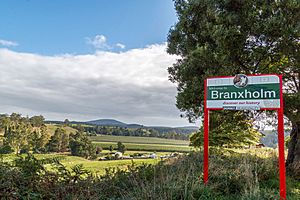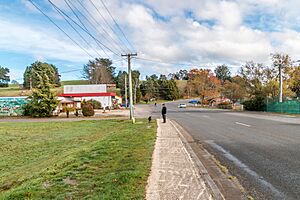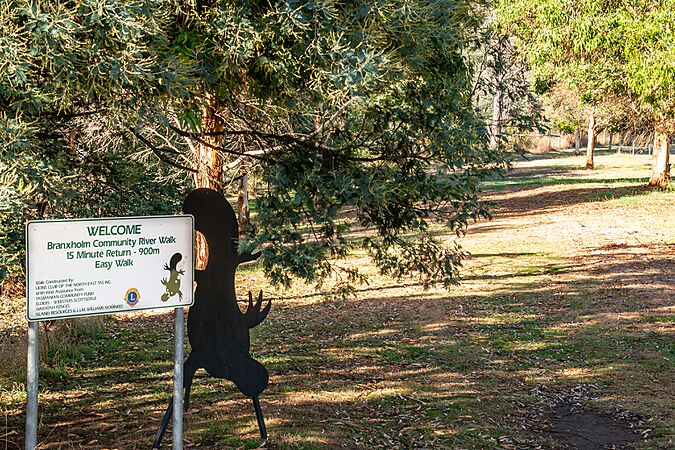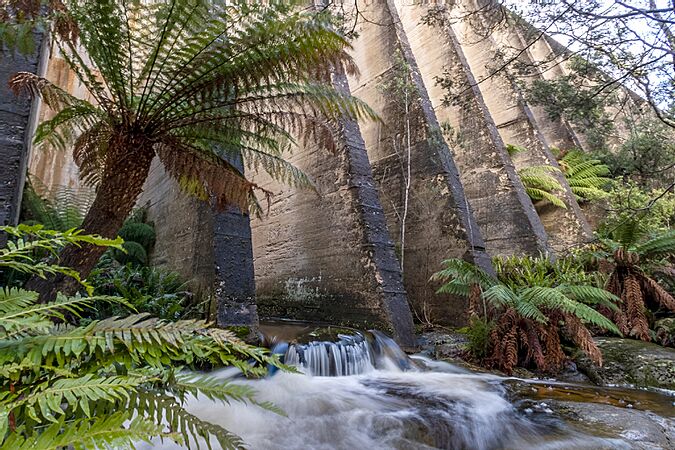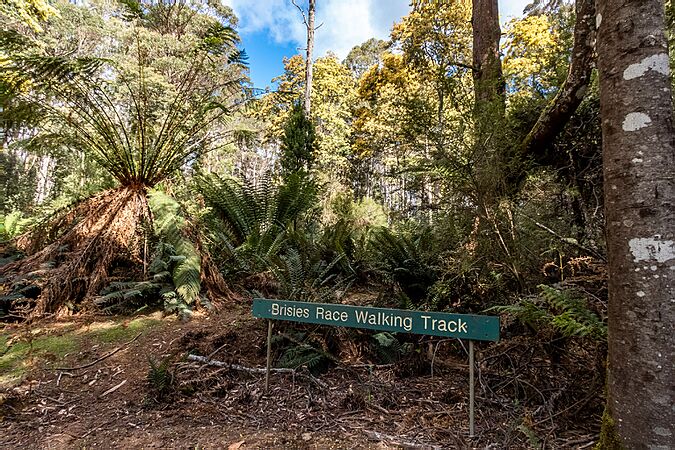Branxholm, Tasmania facts for kids
Branxholm is a pretty rural town in north-east Tasmania, Australia. It sits by the Ringarooma River, about 93 kilometres (58 miles) north-east of Launceston. Branxholm is known for its sawmill, hop farms, and a growing tourism industry. The town is spread out across the valley floor.
Contents
History of Branxholm
The area was first settled by James Reid Scott. He named it Branxholm after a small village in his home country of Scotland. In 1870, there were only three buildings here. But just three years later, in 1873, tin was discovered! This led to a quick boom, and a small shanty town grew up.
The Branxholm Post Office opened its doors on 1 August 1876. By 1877, about 300 people lived in the town. Many more lived in nearby tin mining camps. In 1883, Branxholm was officially declared a town.
In the 1890s, the Warrentinna Goldfield opened just north of the town. Over time, mining became less important. The Golden Mara Mine (for gold) closed in 1920. The Arba Tin Mine, east of town, was not making money by 1921. Eventually, cutting timber replaced mining as the main industry.
In 1970, the first hop fields were planted in the area. Hops are used to make beer.
Since 2015, tourism has become very important for Branxholm. This happened after the Blue Derby Mountain bike trails opened in nearby Derby. Many new businesses, like cafes and places to stay, have opened to welcome visitors.
Things to Do and See
Branxholm's main street has several useful shops and services. You can find a supermarket, a pharmacy, a mechanic, a cafe, and an art gallery. There are also Italian-style and wood-fired pizza restaurants. The historic Imperial Hotel, built around 1907, is also a popular spot. These places serve both the local community and visitors.
If you're looking for a place to stay, Branxholm has several options. You can also find accommodation nearby at the Mara Ponds Gardens. For free camping, head to Centenary Park. It has a tennis and basketball court too!
The Branxholm Community Hall often hosts markets and flower shows. Outdoor events take place at the Public Recreation Grounds. Here you'll find an oval and a netball court.
The Branxholm community riverwalk is a lovely path along the river. It's a great place for fishing, swimming, or enjoying a picnic.
Close to town, Mount Horror offers amazing scenic views. It's surrounded by many pine and gum plantations. The Forestry Commission's fire tower on Mount Horror is open to the public during summer when staff are there.
Branxholm's Tin Mining Past
Tin mining in Branxholm started small. Miners would dig for tin south of the town. They used water from streams to wash out the tin.
In September 1877, tin prices were falling. A disagreement happened when about 12 Chinese miners were trying to reach a mine. A group of European miners stopped them at a bridge in Branxholm. The Chinese miners had to go back to Scottsdale to get police help to pass safely. This event is a notable part of Tasmania's mining history.
As it became harder to find tin easily, bigger mining operations started. These large mines, like the Briseis mine in Derby and the Arba mine in Branxholm, used a lot of money and machinery. Chinese miners were usually not allowed to work in these large mines.
However, Chinese miners continued to work smaller claims. They often worked under a "tribute system," where they paid a share of their findings. This sometimes caused tension with other miners who earned wages.
The red bridge in Branxholm is a special community project finished in 2003. It was built to remember the town's important Chinese mining history.
Mining tin needed a lot of water. Mines often had to close during dry summers. Today, you can still see old mining holes, water channels (called water races), and dams in the forests. These are reminders of the big mining projects.
One amazing project was the Briseis Water Race. It was started in 1901 and built by hand by about 300 men. They worked from both ends of the 48-kilometre (30-mile) path at the same time! It took only 15 months to build. This race brought water from behind Ringarooma to Derby. It supplied 24 million gallons of water daily to the huge Briseis Tin Mine. It took three weeks for the water to reach the mine for the first time!
You can walk a part of this race on the Great Briseis Water Race Walk on Ruby Flats Road. Here you can see deep cuts through solid rock, old stone walls, and parts of wooden structures. These show how much effort went into building it.
The impressive Mount Paris Dam was built in 1937. Its pillar and slab walls helped feed the Mt Paris Mine with an 11-kilometre (7-mile) water race.
Dorset Rail Trail
The Dorset Rail Trail was a project by the local Scottsdale Rotary Club. This trail follows an old railway path. It goes from Tonganah to Tulendeena. The trail is used by people who like to cycle, walk, or ride horses. Every August, there's a competitive event called the Trail Run and Ride. It has different distances, from 2 kilometres (1.2 miles) to 56 kilometres (35 miles).
Railway History
Branxholm used to have its own railway line. This line connected it to Launceston. The State rail system connected Branxholm in 1911.
By 1978, passenger trains stopped running in Tasmania. The railway network, including the line to Branxholm, then focused only on carrying freight. This meant moving logs, woodchips, and other goods. By the early 1980s, there were only three daily services between Scottsdale and Launceston. However, the railway line to Branxholm closed in April 1992. The entire line was closed by 2005.


